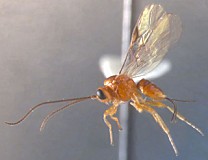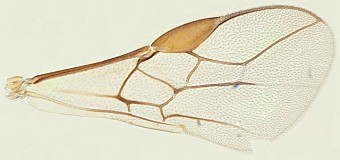Psyttalia concolor (Szépligeti, 1910)
Fischer (1987) later included concolor in the Opius subgenus Psyttalia.
Psyttalia was subsequently elevated to generic rank by Wharton (1987). Almost all of the biological literature on this and related species is under the generic name Opius.
See section on relationships.
Similarly, two decades after the purposeful introduction of P. concolor to Italy to control olive fly, Bactrocera oleae (Rossi), Monastero (1931) described Psyttalia siculus from Sicily as a parasitoid of B. oleae. Considerable debate ensued over whether P. siculus was actually distinct from P. concolor (Monastero, 1934; Delucchi, 1957). Fischer (1963, 1971, 1972) treated P. siculus as a subspecies of P. concolor with slightly longer ovipositor, and retained P. humilis as distinct from P. concolor “because of differences in morphology of developmental stages.”
Three other species from Africa are also difficult to distinguish from Psyttalia concolor: Psyttalia dacicida (Silvestri) reared from Bactrocera oleae in Eritrea, Psyttalia dexter (Silvestri) reared from Dacus longistylus in Senegal, and Psyttalia inconsueta (Silvestri) reared from Carpophthoromyia tritea in southern Nigeria. Almost nothing is known of these three species other than the information provided by Silvestri from his original collections made prior to 1914. Psyttalia lounsburyi (Silvestri) is also similar to concolor and the other species mentioned here but is much darker in coloration. It has been reared from olive fly infesting wild and cultivated olives in South Africa and wild olives in Kenya.
Due to current taxonomic problems, some caution should be exercised in interpretation of the native distribution, as listed in the section below (see the Psyttalia humilis page).
This page was first constructed some time ago. Recent updates include:
Egypt: seasonal abundance (Abd El_Megid, E. J. and Hammad, A. K. K. 1999).
Virus-like particles in poison-glands: Jacas et al., 1997; Wharton, 1997.
A listing of P. concolor introductions to the New World for biological control, prior to 1999, is provided below, summarized from Ovruski et al. 2000. More recently, it has been introduced to California (Johnson et al. (2008)).
Puerto Rico—introduced 1935-37 against Anastrepha suspensa, A. obliqua (Muesebeck 1931).
Costa Rica—introduced in 1956 against Ceratitis capitata; specimens recovered (Hernandez 1996, Wharton et al. 1981, Vaughn 1992).
Bolivia—introduced in 1969 against C. capitata, Anastrepha spp.; specimens recovered, established (Altieri et al. 1989, Bascope 1994, Vaughn 1992).
El Salvador—introduced in 1971 against C. capitata (Hentze et al. 1993, Wharton et al. 1981).
Florida, USA—introduced 1977-79 against A. suspensa (Baranowski et al. 1993).



